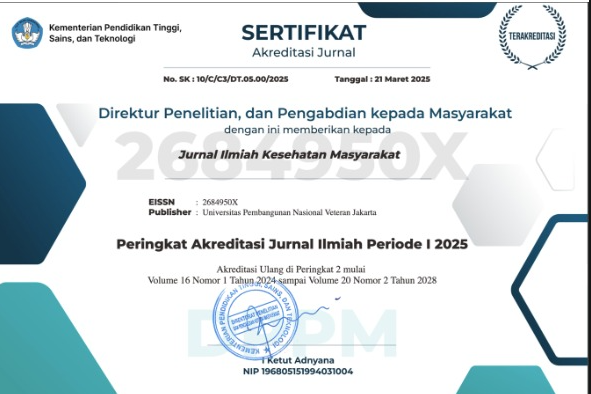Pentingnya Persiapan dalam Pendidikan Kesehatan pada Pasien di Rumah Sakit
Abstract
Latar belakang: pelaksanaan pendidikan kesehatan penting dilaksanakan rumah sakit. Tujuan penelitian ini untuk mengetahui faktor-faktor yang hubungan dengan pelaksanaan pendidikan kesehatan di rumah sakit. Metode: analisis multivariat terhadap 81 perawat pelaksana, dipilih dengan cosecutive sampling. Pengukuran faktor yang mempengaruhi pendidikan kesehatan menggunakan kuesioner ( Cronbach= 0,953; 0,870).
Hasil: Faktor yang mempengaruhi pelaksanaan pendidikan kesehatan yang baik di antaranya persiapan, lingkungan dan sumber daya, serta sikap pasien (p=0,008; p=0,004; p= 0,023). Faktor yang paling dominan berpengaruh yaitu persiapan pendidikan kesehatan (p=0,013; OR=3,87).
Kesimpulan: Persiapan pelaksanaan pendidikan kesehatan meningkatkan perawat pelaksana untuk melaksanakan pendidikan kesehatan dengan baik sebesar 3, 87 kali lebih tinggi dibanding pendidikan kesehatan yang tidak dipersiapakan dengan baik. Rekomendasi yang muncul dari penelitian ini agar meningkatkan pemahaman perawat akan perannya dalam melaksanakan pendidikan kesehatan, dengan melakukan persiapan dan menggunakan sumber daya yang ada.
Background: the implementation of health education at hospital is important. Objective this research to determine the factors most related to implementation of health education at hospital.
Methods: descriptive cross sectional analytic to 81 nurses, chosen by cosecutive sampling. Measurement of factors that affect the implementation of health education using questionnaires.
Results: Factors that influence health education is going well including preparation, environment and resources, and patient’s attitudes (p=0.008; p=0.004; p= 0.023). Among the three factors that affect the implementation of health education, found that the most dominant factor is preparation to implementation of health education (p=0.013; OR=3.87).
Conclusion: preparation to implementation of health education would give 3.87 times greater chance for nurses to conduct health education are well compared with preparation are not do well. Recommendation from this study is increase the understanding of its role and nurse will carry out health education, the preparation and use of available resources.
References
Marquis, B. L,. & Huston, C. J. (2012). Leadershift role and Management fuctions in nursing: Theory & aplication. Philadelphia: Wolter Kluwer Health / Lippincott William & Wilkins.
Oermann, M. H., & Templin, T. (2000). Important attributes of quality health care: Consumer perspectives. Journal of Nursing Scholarship,32(2),167-72.Retrievedfrom http://search.proquest.com/docview/236456357?accountid=17242
Clark, M. J. (1990). Nursing in the community: dimension of community health nursing. Connecticut: Appleton & Lange.
Marcum, J., Ridenour, M., Shaff, G., Hammons, M., & Taylor, M. (2002). A study of professional nurses' perceptions of
patient education. The Journal of Continuing Education in Nursing, 33(3),112-8.Retrievedfrom http: //search. proquest. com/docview/ 223324613?accountid=17242
The Joint Commision on Accreditation of Health Care Organization. (2012). Behavior health care: 2013 National Patient Safety Goals. http//www. jointcommission. Org/standards information /npsgs.aspx
Barkowski, N. (2011). Organizational behavior in health care. New York: Jones and Barlett Publisher LL
Potter, P. A., & Perry, A. G. (2009). Fundamental of nursing, 9th edition. Singapore: Mosby Elsivier Pte Ltd.
Klein-Fedyshin, M., Burda, M. L., Epstein, B. A., & Lawrence, B. (2005). Collaborating to enhance patient education and recovery*. Journal of the Medical Library Association, 93(4),440-5. Retrieved from. http://search.proquest.com/docview/203474437? Accountid =17242
Nurhidayah, E. N. (2010). Ilmu perilaku dan pendidikan kesehatan untuk perawat. Medan: USU Press.
Park, M.Y.(2005).Nurses‟perception of performance and responsibility of patient education. Journal of Korean Academy of Nursing Vol. 35, No. 8, 1514-1521
Park, M. Y. & McMillan, M. A. (2000). Patient education in the face of work constraints. Paper presented at the 1st Asia-Pacific
Haratani, R. (2010). Optimizing wait time using smart phones as a patient empowerment tool. California State University, Long Beach). ProQuest Dissertations and Theses,, 45. Retrieved from http: // search. proquest.com/docview/860323327?accountid=17242. (860323327).
Nursalam & Efendi, F,. (2009). Pendidikan dalam keperawatan. Jakarta: Salemba medika.









.jpg)








